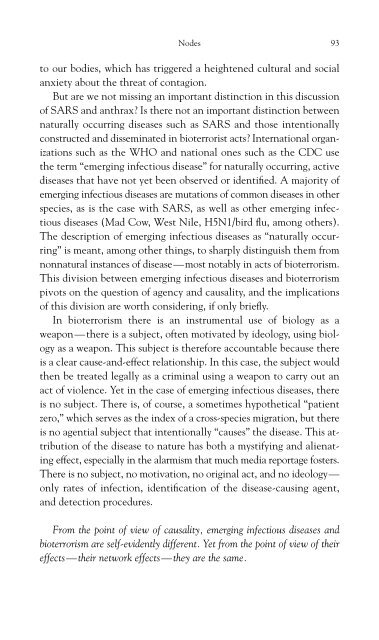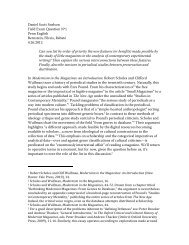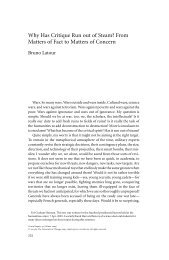The Exploit: A Theory of Networks - asounder
The Exploit: A Theory of Networks - asounder
The Exploit: A Theory of Networks - asounder
You also want an ePaper? Increase the reach of your titles
YUMPU automatically turns print PDFs into web optimized ePapers that Google loves.
Nodes 93<br />
to our bodies, which has triggered a heightened cultural and social<br />
anxiety about the threat <strong>of</strong> contagion.<br />
But are we not missing an important distinction in this discussion<br />
<strong>of</strong> SARS and anthrax? Is there not an important distinction between<br />
naturally occurring diseases such as SARS and those intentionally<br />
constructed and disseminated in bioterrorist acts? International organizations<br />
such as the WHO and national ones such as the CDC use<br />
the term “emerging infectious disease” for naturally occurring, active<br />
diseases that have not yet been observed or identified. A majority <strong>of</strong><br />
emerging infectious diseases are mutations <strong>of</strong> common diseases in other<br />
species, as is the case with SARS, as well as other emerging infectious<br />
diseases (Mad Cow, West Nile, H5N1/ bird flu, among others).<br />
<strong>The</strong> description <strong>of</strong> emerging infectious diseases as “naturally occurring”<br />
is meant, among other things, to sharply distinguish them from<br />
nonnatural instances <strong>of</strong> disease—most notably in acts <strong>of</strong> bioterrorism.<br />
This division between emerging infectious diseases and bioterrorism<br />
pivots on the question <strong>of</strong> agency and causality, and the implications<br />
<strong>of</strong> this division are worth considering, if only briefly.<br />
In bioterrorism there is an instrumental use <strong>of</strong> biology as a<br />
weapon—there is a subject, <strong>of</strong>ten motivated by ideology, using biology<br />
as a weapon. This subject is therefore accountable because there<br />
is a clear cause - and - effect relationship. In this case, the subject would<br />
then be treated legally as a criminal using a weapon to carry out an<br />
act <strong>of</strong> violence. Yet in the case <strong>of</strong> emerging infectious diseases, there<br />
is no subject. <strong>The</strong>re is, <strong>of</strong> course, a sometimes hypothetical “patient<br />
zero,” which serves as the index <strong>of</strong> a cross - species migration, but there<br />
is no agential subject that intentionally “causes” the disease. This attribution<br />
<strong>of</strong> the disease to nature has both a mystifying and alienating<br />
effect, especially in the alarmism that much media reportage fosters.<br />
<strong>The</strong>re is no subject, no motivation, no original act, and no ideology—<br />
only rates <strong>of</strong> infection, identification <strong>of</strong> the disease - causing agent,<br />
and detection procedures.<br />
From the point <strong>of</strong> view <strong>of</strong> causality, emerging infectious diseases and<br />
bioterrorism are self - evidently different. Yet from the point <strong>of</strong> view <strong>of</strong> their<br />
effects—their network effects—they are the same.









